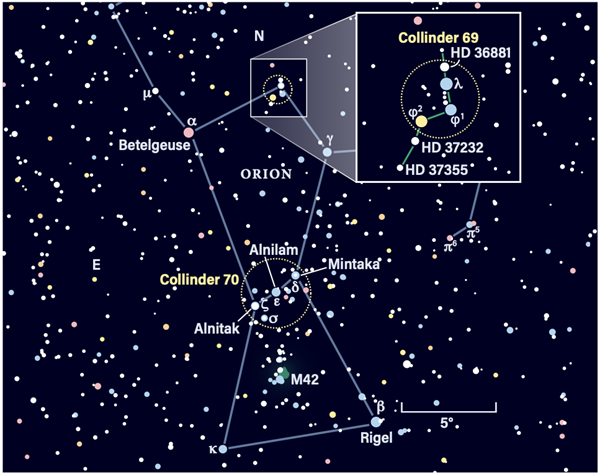Without a question, Orion the Hunter tops the list when it comes to renowned constellations. The reason is simple: Orion demands our attention because it is visible around the globe this time of year. Its brightest stars — Betelgeuse (Alpha [α] Orionis) and Rigel (Beta [β] Orionis) — are discernible in all but the severest light polluted skies. And, visible through binoculars and telescopes, the Hunter hosts one of the sky’s most famous sights: the Orion Nebula (M42).
But there is much more to see within Orion than these familiar gems. This month, we are going to hunt for some of the Hunter’s lesser-known targets.
Raise your binoculars toward Orion’s Belt. The three equally spaced stars that form the Belt are, from west to east, Mintaka (Delta [δ] Orionis), Alnilam (Epsilon [ε] Orionis), and Alnitak (Zeta [ζ] Orionis). These stellar belt loops are among the hottest stars visible to the unaided eye.
As you view the scene through your binoculars, notice how the many fainter stars that surround the Belt appear to form a football-shaped pattern parallel to the Belt. An S-shaped asterism of a dozen stars winds its way from Mintaka to Alnilam; if we imagine those dim stars as a football, maybe the S is its stitching.
Centered on Alnilam is a collection of more than 70 stars belonging to Collinder 70. The Collinder catalog, published in 1931 by Swedish astronomer Per Collinder, includes 471 open clusters. Some are cross listed in the Messier and NGC catalogs, while others, like Collinder 70, are not.
Collinder 70 contains more than 100 widely separated stars. For instance, Mintaka and Alnitak are estimated to lie some 900 and 800 light-years away, respectively, but Alnilam is another 400 or so light-years farther out. The stars in Collinder 70 belong to the Orion OB1 association. OB associations are loose collections of young, hot, type O and B stars often separated by tens or hundreds of light-years.
Another member of the Collinder catalog lies north of Collinder 70. Collinder 69 overlays Orion’s tiny triangular head, so it is also easy to locate. Some references call it the Lambda (λ) Orionis Cluster, since third-magnitude Lambda, also known as Meissa, is the brightest member.
Long before it was recognized as a cluster, Orion’s head drew attention. In his 1888 book Astronomy With an Opera-Glass, Garrett P. Serviss wrote, “Although there is no nebula here, yet these stars, as seen with the naked eye, have a remarkably nebulous look.”
Binoculars resolve Collinder 69 into a scattered collection of about 20 stars strewn across 70′. Three stars stand out in the field. Their equal spacing and similar brightness remind me of a miniaturized Orion’s Belt. At the center is Lambda, while Phi1 (φ1) sits to its south and 6th-magnitude HD 36881 lies to its north. The southeastern star in Orion’s head, Phi2 (φ2) Orionis, is not a cluster member.
Serviss noted a faint glimmering between Lambda and Phi1. He explained how “a field-glass shows that this twinkling is produced by a pretty little row of three stars of the eighth and ninth magnitudes.”
Serviss was wrong about one thing, however, when he said there is no nebula here. He would be amazed to learn that the entire area is engulfed in a huge glowing cloud of gas and dust cataloged as Sharpless 2–264. Although invisible through binoculars, it appears as a large sphere of ionized hydrogen in images.
Expand the scene to include Phi2, as well as stars HD 37232 and HD 37355 to its southeast, and you get an asterism that looks like a Recliner. That’s how reader Hope Harle-Mould near Buffalo, New York, interprets it. HD 36881 and Phi1 form the back, while Phi1 to Phi2 and those other two HDs make the seat and leg extension. So, kick up your feet and see if you can also imagine a comfy chair here.
Next month, we’ll head south for a late winter getaway. Questions, comments, suggestions are always welcome. Contact me through my website, philharrington.net. Until next time, remember that two eyes are better than one.










